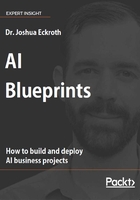
What you need for this book
This book uses state-of-the-art techniques and software libraries. For whatever reason, the original development of these libraries is typically done on Linux or macOS machines before being ported to Windows. Thus, it is possible some libraries might be difficult to install on a Windows machine, though Microsoft's Ubuntu on Windows 10 technology is helping close this gap. For example, TensorFlow has supported Windows for several years but difficulties installing it remained even in 2017 (https://github.com/tensorflow/tensorflow/issues/42).
Libraries are rapidly changing, so there is little use in detailing installation procedures in this Preface. A list of required libraries for each chapter are provided on this book's code repository: https://github.com/PacktPublishing/AIBlueprints. Installation procedures differ for each library and sometimes change as new versions are released. These instructions may be found on the library's linked homepage.
I intentionally chose to use state-of-the-art libraries even though they undergo rapid development and change. This change is usually for the better, but sometimes new versions break existing code or cannot be installed without some effort. However, I felt that it would not be helpful to write a book about old technology. For example, all Python applications in this book use Python 3.6 (or later) even though many may still work with minor changes in a Python 2.7 environment. Likewise, we use TensorFlow 1.10, the latest release at the time of writing. Books with code designed for TensorFlow 0.12, for example, will need significant updates, even though 0.12 was released less than two years ago.
Speaking of TensorFlow, if you have a GPU, you will find the code we develop in Chapter 5, A Blueprint for Detecting Your Logo in Social Media to be significantly more efficient, and better (more expensive) GPUs give even more performance gains. Even so, TensorFlow will still work with just a CPU.
Download the example code files
You can download the example code files for this book from your account at http://www.packt.com. If you purchased this book elsewhere, you can visit http://www.packt.com/support and register to have the files emailed directly to you.
You can download the code files by following these steps:
- Log in or register at http://www.packt.com.
- Select the SUPPORT tab.
- Click on Code Downloads & Errata.
- Enter the name of the book in the Search box and follow the on-screen instructions.
Once the file is downloaded, please make sure that you unzip or extract the folder using the latest version of:
- WinRAR / 7-Zip for Windows
- Zipeg / iZip / UnRarX for Mac
- 7-Zip / PeaZip for Linux
The code bundle for the book is also hosted on GitHub at https://github.com/PacktPublishing/ProgrammingAIBusinessApplications. In case there's an update to the code, it will be updated on the existing GitHub repository.
We also have other code bundles from our rich catalog of books and videos available at https://github.com/PacktPublishing/. Check them out!
Download the color images
We also provide a PDF file that has color images of the screenshots/diagrams used in this book. You can download it here: https://www.packtpub.com/sites/default/files/downloads/9781788992879_ColorImages.pdf.
Conventions used
There are a number of text conventions used throughout this book.
CodeInText: Indicates code words in text, database table names, folder names, filenames, file extensions, pathnames, dummy URLs, user input, and Twitter handles. For example; "Mount the downloaded WebStorm-10*.dmg disk image file as another disk in your system."
A block of code is set as follows:
[default] exten => s,1,Dial(Zap/1|30) exten => s,2,Voicemail(u100) exten => s,102,Voicemail(b100) exten => i,1,Voicemail(s0)
When we wish to draw your attention to a particular part of a code block, the relevant lines or items are set in bold:
[default]
exten => s,1,Dial(Zap/1|30)
exten => s,2,Voicemail(u100)
exten => s,102,Voicemail(b100)
exten => i,1,Voicemail(s0)
Any command-line input or output is written as follows:
# cp /usr/src/asterisk-addons/configs/cdr_mysql.conf.sample
/etc/asterisk/cdr_mysql.conf
Bold: Indicates a new term, an important word, or words that you see on the screen, for example, in menus or dialog boxes, also appear in the text like this. For example: "Select System info from the Administration panel."
Note
Warnings or important notes appear like this.
Tip
Tips and tricks appear like this.